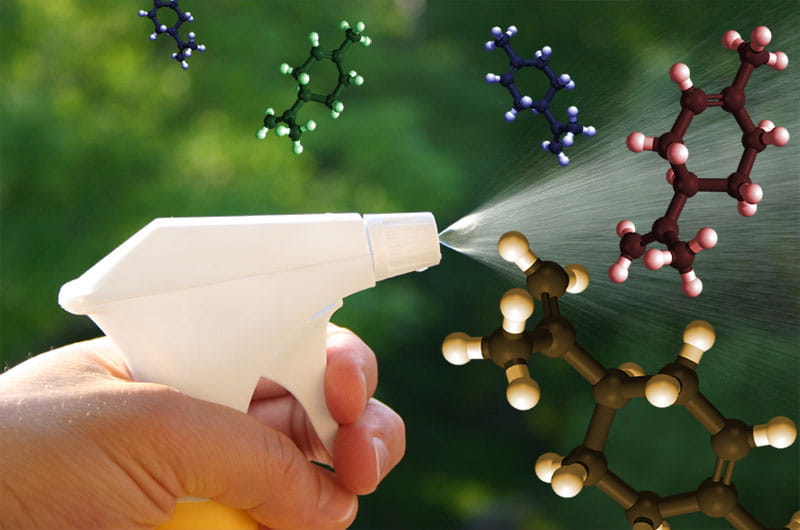Clean Smell Doesn't Always Mean Clean Air

- Drexel Environmental Collaboratory Releases Cross-Sector Findings on Severe Weather Recovery Challenges
- Drexel Launches the Manuel Stamatakis Center for Alternative Investments at the LeBow College of Business
- How and When Could AI Be Used in Emergency Medicine?
- Faculty Highlights: Recent Awards and Grants

Michael Waring, PhD, an assistant professor in the College of Engineering, is examining spikes in indoor aerosol particles caused by cleaning products and air fresheners.
Some of the same chemical reactions that occur in the atmosphere as a result of smog and ozone are actually taking place in your house while you are cleaning. A researcher in Drexel’s College of Engineering is taking a closer look at these reactions, which involve an organic compound -called limonene- that provides the pleasant smell of cleaning products and air fresheners. His research will help to determine what byproducts these sweet-smelling compounds are adding to the air while we are using them to remove germs and odors.
Secondary organic aerosols (SOAs) are microscopic particles created when ozone reacts with volatile organic gases such as limonene –the chemical name for the smell of oranges- or its cousin α-pinene, which is part of the smell of pine trees. Outdoors, this reaction happens all the time. It drives the formation of much of the atmospheric organic aerosol present in our environment. And in, population-dense urban areas -where enough suspended particles can be amassed- it contributes to the formation of the visible haze called smog.
While a large amount of aerosols that exist in the Earth’s atmosphere are naturally occurring – created by processes such as mechanical suspension by wind or sea spray – much is produced as a result of industrialization. And while researchers are still striving to fully understand the health and environmental impact of increased levels of secondary organic aerosols in the atmosphere, studies have linked exposure to outdoor aerosols generally to morbidity and mortality outcomes.
Few researchers, however, have considered the formation of SOAs in our indoor environments. Michael Waring, PhD, an assistant professor in Drexel University’s College of Engineering, is taking the deepest look yet at the formation and behavior of these particles indoors.
“SOAs can come from ozone reactions with numerous sources, especially with compounds called terpenes that produce the scents we associate with cleaners, pine, lavender, and oranges,” Waring said. “Limonene is the terpene that makes an orange’s smell. It’s a very popular scent for cleaning products, so we’re taking a closer look at how it reacts indoors –where people are using it in high concentrations.”
The first step toward understanding the health implications is finding how many of these microscopic SOA particles are created when household cleaning products and air fresheners react with ozone indoors. In research recently published in Environmental Science & Technology, Waring describes the role of limonene, the organic compound that gives cleaners and air fresheners an orange scent and acts as a solvent, in the formation of secondary organic aerosols.
For the research, Waring and his team used an air testing chamber that they specifically designed to study the reactive behavior of air in an indoor environment. With it, they were able to simulate limonene being added to the environment in pulses – the way it would be introduced indoors when spraying a limonene-containing cleaning product. They are also able to control the amount of ozone in the chamber – an aspect of indoor environments that can vary with outdoor ozone concentrations and the opening of windows and doors or the use of a few certain household appliances.
By adjusting elements of the test, such as the air exchange rate, which is the number of times per hour indoor air is replaced by outdoor air, as well as the concentrations of terpene and ozone in the chamber, the group was able to ascertain how those variables each affected the formation of secondary organic aerosols.
This process is unique to Waring’s research. Other labs have undertaken this sort of examination, but almost always using a constant flow of terpene and ozone into the environment. But by pulsing limonene into the chamber operated at different air exchange rates, the Drexel researchers are more closely recreating actual usage scenarios in hopes of generating more representative results.
“We found that one of the biggest factors contributing to SOA formation by limonene ozonolysis was the air exchange rate,” Waring said. “This is because certain chemical reactions that form SOAs take longer than others. If the air is exchanged before these reactions can take place then the SOA production is weaker indoors.”
With 18 different scenarios tested, the team calculated a range of peak formation of secondary organic aerosols when typical concentrations of limonene were introduced to ozone-rich environments with a range of air exchange rates. The resulting mass concentration of secondary organic aerosols was roughly between five and 100 μg/m3.
“For reference, the EPA’s National Ambient Air Quality Standard for fine aerosol is an annual average of 12 μg/m3. Our findings show a significant enough range of SOA formation to warrant more in depth public health studies,” Waring said. “This research is particularly necessary in order to understand health impacts on people who use significant amounts of cleaning products such as housecleaners or custodians. The goal of our work is to help that process by providing accurate numbers for researchers to use in risk calculation models. It is the most robust work of its kind thus far and has generated quite a bit of useful data.”
While the next step in this line of research would be to examine the health impacts of indoor SOA, a few ways to reduce indoor aerosols would be to use unscented cleaners and open windows while cleaning. Even though open windows bring in more ozone from outside, the reduction in the indoor limonene concentration and SOA formation strength more than make up for it, as less secondary organic aerosol is formed inside.
Drexel News is produced by
University Marketing and Communications.